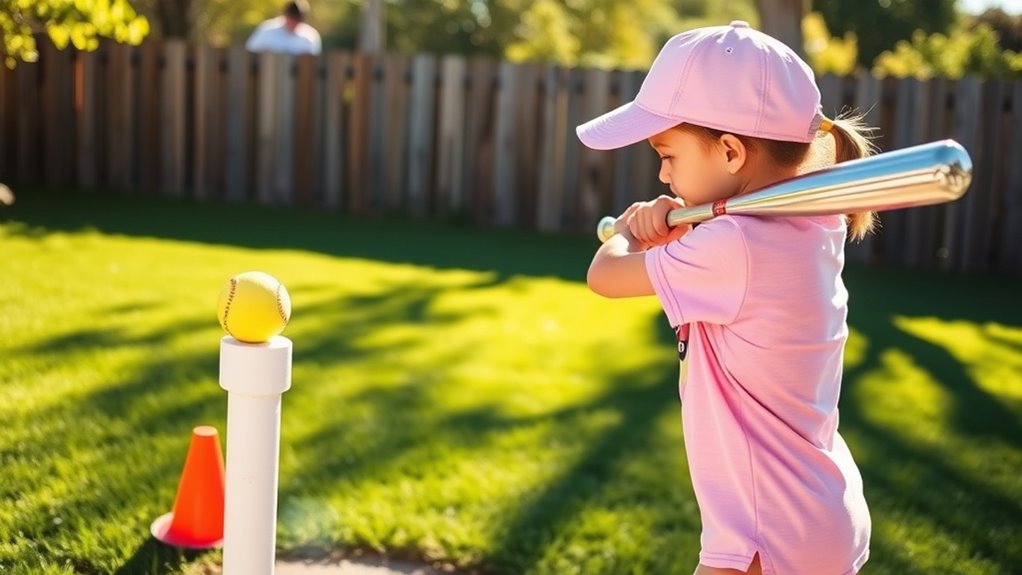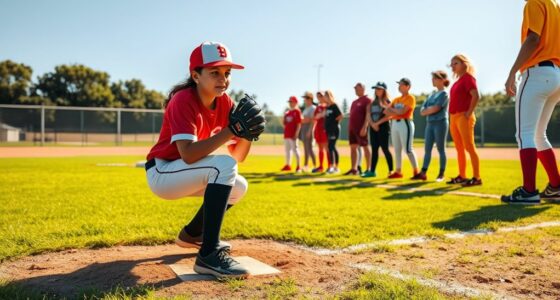To improve your softball skills at home, try five simple drills: soft toss to boost batting accuracy, wall catch to sharpen fielding, target throwing for arm strength, cone drills to enhance agility, and softball dribbling for hand-eye coordination. Focus on proper technique and controlled movements in each exercise. These easy practices can help build your confidence and skill level. Keep going, and you’ll discover even more effective ways to develop as a player.
Key Takeaways
- Use soft toss drills to improve batting accuracy and hand-eye coordination at home.
- Practice wall catch exercises to enhance fielding skills and reflexes against a sturdy surface.
- Focus on target throwing to develop arm strength and precision with minimal equipment.
- Set up cone drills to boost agility, footwork, and coordination in small spaces.
- Incorporate softball dribbling and glove work exercises to strengthen hand-eye coordination and control.
Soft Toss Drill to Improve Batting Accuracy
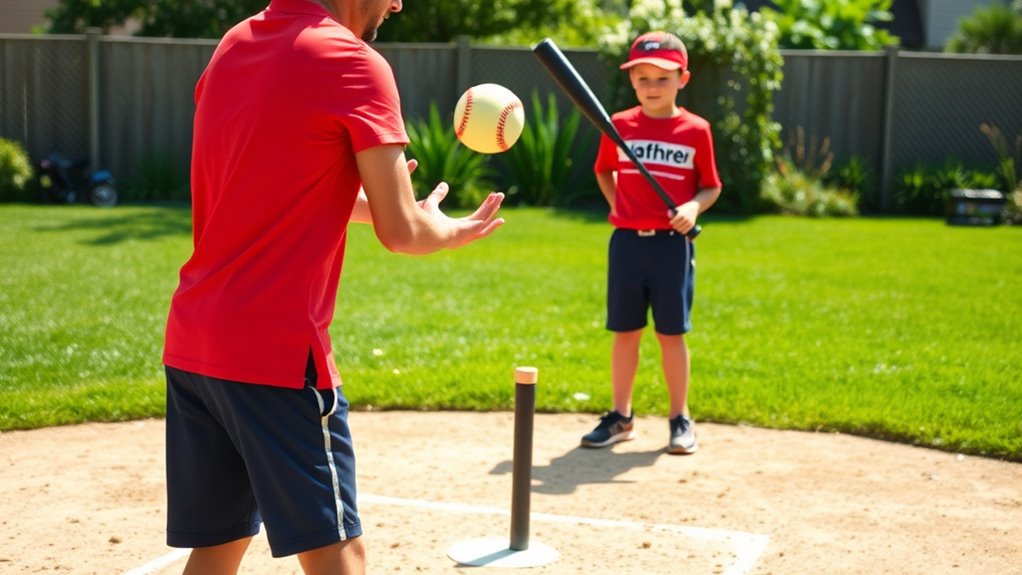
To improve your batting accuracy, the soft toss drill is an effective and straightforward practice. Stand in your batting stance, keeping your feet shoulder-width apart and your knees slightly bent. Hold the bat comfortably, focusing on your swing mechanics. Have a partner or use a tee to softly toss balls from the side, aiming for consistent placement. As the ball approaches, focus on maintaining your proper stance and executing a smooth, controlled swing. This drill helps you develop better hand-eye coordination and reinforces correct swing mechanics, making your hits more accurate. Keep your eyes on the ball and adjust your stance if needed. Regular practice will build muscle memory, leading to more confident and precise swings during games.
Wall Catch Practice to Enhance Fielding Skills

Wall catch practice is an excellent way to sharpen your fielding skills and improve quick-reaction plays. Stand a few feet from the wall, adopt your catching stance—feet shoulder-width apart, knees slightly bent, and glove ready. Focus on proper glove positioning to guarantee you’re prepared to catch balls cleanly. Toss the ball against the wall with controlled force, catching it with your glove without letting it bounce away. As you catch, keep your eyes on the ball and stay in your catching stance to maintain balance and readiness. Practice alternating between forehand and backhand catches to build versatility. This drill helps develop quick reflexes, proper glove positioning, and muscle memory, all vital for becoming a confident and reliable fielder. Incorporating fielding drills like this into your routine can significantly boost your overall performance on the field.
Target Throwing for Better Arm Strength and Precision

Target throwing is an effective drill to boost your arm strength and accuracy, helping you become a more consistent and confident thrower. To succeed, focus on your target grip, ensuring a firm yet relaxed hold on the ball. Pay attention to your throwing mechanics by maintaining proper body posture, stepping toward your target, and following through smoothly. Here are four tips to improve your target throwing:
- Choose a specific target, like a bucket or marked spot.
- Use your fingers to grip the ball firmly but comfortably.
- Practice consistent throwing mechanics with controlled arm motion.
- Aim for precision over power, focusing on hitting the target accurately.
Additionally, observing professional techniques through expert voice actors can provide insights into proper delivery and form to enhance your technique.
Cone Drills to Boost Agility and Footwork
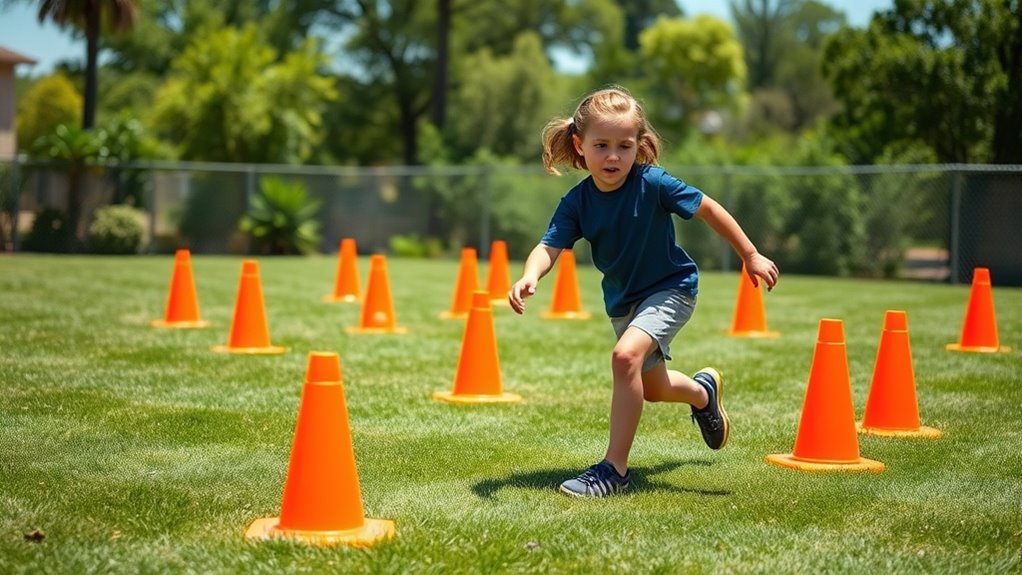
Incorporating cone drills into your practice routine can substantially improve your agility and footwork on the field. These drills are effective for practicing footwork techniques that enhance your ability to change direction quickly and stay balanced. Set up cones in various patterns, such as zigzags or circles, to simulate game situations. As you move between cones, focus on quick, controlled steps and maintaining proper posture. These agility exercises help develop explosive movement and coordination, making you more agile during plays. Consistent practice with cone drills builds muscle memory, so your footwork becomes instinctive during games. To maximize your training, consider the importance of size restrictions and space optimization strategies that can be applied to your drill setup and overall practice space. Incorporate different patterns and speeds to challenge yourself and maximize your agility and footwork improvements over time.
Softball Dribbling for Hand-Eye Coordination
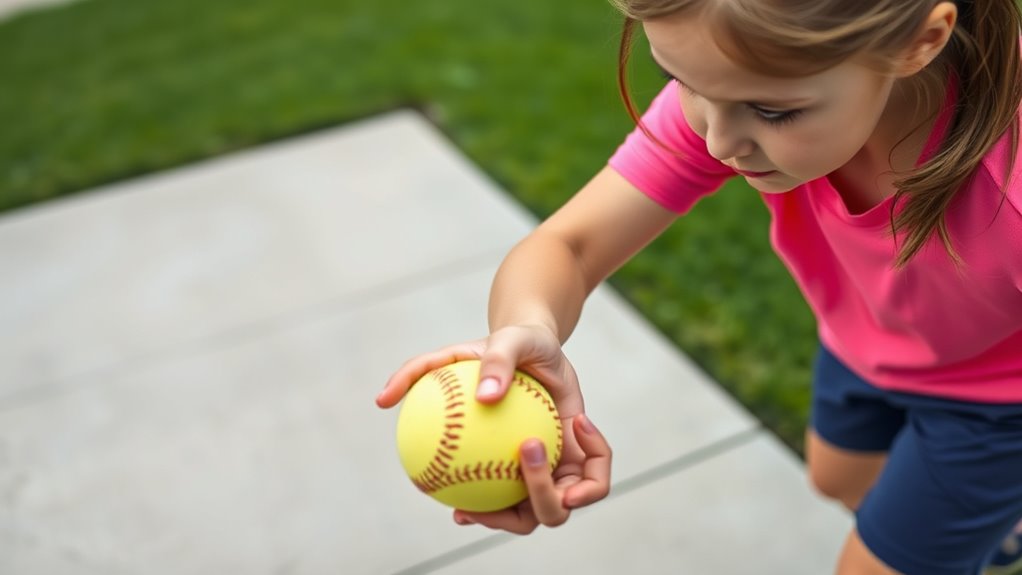
Practicing softball dribbling is an effective way to improve your hand-eye coordination, which is essential for making accurate throws and catches during games. To enhance your skills, focus on these key activities:
- Softball Bouncing Drill: Bounce the ball softly on the ground and catch it with your glove, sharpening your glove work.
- Wall Toss: Toss the ball against a wall, catching it with your bare hand to improve bat control and timing.
- Target Practice: Set targets and aim your throws, emphasizing accuracy and control.
- Controlled Drills: Dribble the ball slowly while moving, mimicking game scenarios to boost overall coordination. These exercises strengthen your glove work and help you develop better bat control, making you more confident on the field.
Additionally, incorporating focused practice can accelerate your progress and reinforce muscle memory.
Frequently Asked Questions
What Equipment Is Necessary for Beginner Softball Drills at Home?
For beginner softball drills at home, you mainly need a bat, gloves, and soft toss balls. A bat helps you practice swinging, while gloves protect your hands and improve catching. Soft toss balls are perfect for controlled hitting practice. You don’t need much equipment to get started—just a safe space, your gear, and a willingness to improve. With these essentials, you can build your skills comfortably at home.
How Often Should Beginners Practice Softball Drills for Best Results?
In the spirit of the 21st century, you should aim to practice softball drills 3-4 times a week. Consistent practice helps improve your skills and builds muscle memory. Keep a skill assessment journal to track progress and identify areas for improvement. By maintaining practice consistency, you’ll see steady improvement and become more comfortable on the field. Remember, regular effort leads to better results, so stay committed!
Can These Drills Be Adapted for Different Age Groups?
You can definitely adapt these drills for different age groups by using age-appropriate modifications and adjusting for skill level. Younger players might need simpler tasks, while older or more advanced players can handle more challenging exercises. Focus on skill level adaptation by modifying drill difficulty, equipment, or timing. This guarantees everyone stays engaged, develops proper techniques, and builds confidence regardless of age, making your practice sessions effective and inclusive.
Are There Safety Precautions to Consider During At-Home Practice?
Safety should be your top priority during at-home softball practice. Always wear protective gear like helmets, gloves, and pads to prevent injuries. Create a clutter-free, clear space to avoid accidents and guarantee a safe practice environment. Stay focused and avoid overexertion to prevent fatigue-related mishaps. Prioritize safe practice by following these precautions, so you can sharpen your skills securely and enjoy softball safely at home without unnecessary setbacks.
How Can I Track Progress and Improve Over Time?
To track progress and improve over time, you should regularly record your performance during drills, noting areas where you excel or struggle. Use a journal or app to log your results, making it easy to see your progress. Focus on specific skills, set goals, and review your records weekly. This progress tracking helps you stay motivated and guides your practice, ensuring consistent skill improvement.
Conclusion
So, there you have it—five foolproof drills to turn you into a softball superstar from your backyard. Who knew that a simple wall or some cones could unleash your hidden talent? Just remember, practice makes perfect, or at least keeps you busy while pretending you’re the next big thing. So grab your gear, get moving, and maybe—just maybe—you’ll surprise everyone (including yourself) someday. Happy practicing, future champion!
